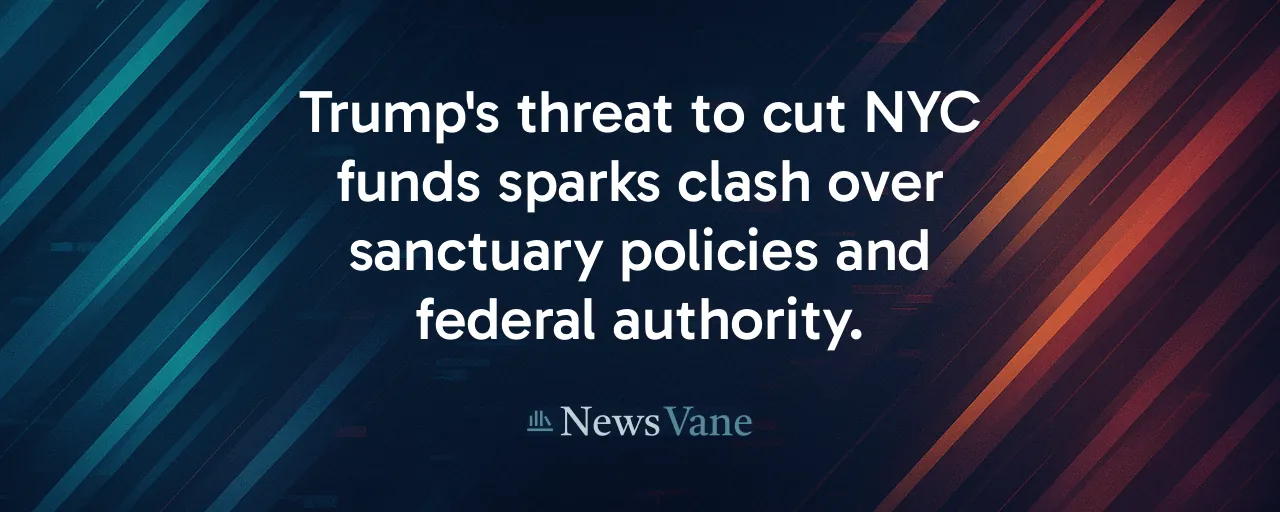A City Under Pressure
President Donald Trump's recent pledge to 'save' New York City has ignited a firestorm. In a series of fiery statements, he vowed to withhold federal funds and ramp up immigration enforcement, targeting the city's leadership, particularly Assemblyman Zohran Mamdani, the Democratic mayoral nominee. Trump's rhetoric, framing the city as spiraling under progressive policies, signals a broader clash over power, immigration, and local autonomy.
The threats come as New York City navigates a delicate balance. With a $112 billion budget, of which roughly 7% comes from federal grants, the city relies on these funds for schools, hospitals, and transit. However, its sanctuary-city policies, which limit cooperation with federal immigration authorities, have drawn Trump's ire. The stakes are high, touching on economic stability, public safety, and the rights of immigrant communities.
The standoff highlights a broader conflict, raising a critical question: How can federal and local governments resolve disputes over divisive issues like immigration without punishing residents or escalating tensions? The answer lies in pragmatic solutions that respect both national priorities and local realities.
The Heart of the Conflict
At the core of this dispute is a tug-of-war over authority. The federal government holds sway over immigration policy, but localities like New York City can choose whether to assist. Sanctuary policies, which protect undocumented immigrants by limiting cooperation with Immigration and Customs Enforcement (ICE), are legal but contentious. Trump argues these policies undermine national security and law enforcement.
New York City, however, sees its approach as a defense of community trust. City leaders point to evidence showing immigrants, regardless of status, commit crimes at lower rates than native-born residents. A 2022 Stanford study found no significant crime increase in sanctuary cities compared to others, suggesting these policies don't inherently jeopardize safety.
Trump's proposed solution, cutting federal funds, could hit hard. Losing up to $8 billion might disrupt schools, healthcare, and transit projects like the MTA's capital plan. However, legal experts warn such cuts face hurdles. Past attempts to penalize sanctuary cities were blocked by courts, citing limits on federal power to coerce local governments.
A City's Resilience Tested
New York City's history offers perspective. The city has long clashed with federal authorities, from tax disputes to policy fights. During Trump's first term, efforts to defund sanctuary cities faltered in court, with judges upholding local autonomy. These legal victories bolster the city's confidence, but the current threats feel different, more personal and direct.
Crime, a key concern in Trump's rhetoric, adds complexity. While felony assaults are about 40% higher than in 2019, overall crime remains far below 1990s peaks. Economic analyses also highlight the contributions of immigrants, who fuel industries like construction and hospitality. Punitive measures risk alienating these workers and unsettling the city's municipal bond market, which investors watch closely.
Voices on the Ground
Residents feel the tension. Immigrant communities, already wary, fear heightened ICE operations could disrupt lives and deter civic engagement. Business owners, reliant on immigrant labor, worry about economic ripple effects. Meanwhile, some New Yorkers, frustrated by rising crime, align with calls for tougher enforcement, as shown in recent Siena polls.
City officials, from Mayor Eric Adams to Governor Kathy Hochul, face pressure to respond. Legal action is likely, with the state poised to challenge any funding cuts in court. Advocacy groups, like those defending immigrant rights, are mobilizing, emphasizing due process and community safety over federal mandates.
Paths to Resolution
Despite the rhetoric, opportunities for compromise exist. Targeted agreements, like sharing data on violent felons, could bridge gaps without undermining sanctuary principles. Joint crime-reduction initiatives, funded by federal grants, might align local and national goals. A phased review of policies, ensuring judicial oversight, could build trust.
Economic realities demand cooperation. Abrupt funding cuts would strain city services and invite lawsuits, delaying outcomes. Immigration enforcement, too, faces practical limits: ICE lacks the resources for mass deportations, and local police prioritize community trust over federal tasks. Both sides benefit from de-escalation.
Looking Ahead
New York City's future hinges on navigating this standoff with clarity and resolve. Balancing federal pressures with local priorities requires dialogue, not ultimatums. Evidence-based strategies, drawing on data about crime, immigration, and economic impacts, can guide the way.
The broader lesson is clear: Governance thrives on collaboration, not coercion. Cities and the federal government need to find ways to align on shared goals, like public safety and economic stability, while respecting differences. New York's resilience, forged through decades of challenges, will be tested again.
As this drama unfolds, one thing remains certain. The choices made today will shape a city and the delicate balance of power in a divided nation. Finding common ground won't be easy, but it's the only way to move forward without leaving anyone behind.
